PSY171: Child Development Analysis of Kid History Video
VerifiedAdded on 2023/05/29
|10
|2612
|120
Report
AI Summary
This report analyzes a 'Kid History' video, focusing on the physical, cognitive, and social development of three children narrating a family event. The report examines each child's developmental stage based on their age, behavior, and speech patterns, referencing developmental theories. It explores the children's physical abilities, including gross and fine motor skills, and cognitive development, such as language skills, logical reasoning, and moral understanding. The analysis also considers the children's social development, assessing their interaction styles and communication skills. The report concludes with a reflection on the learning experience and the application of theoretical knowledge to real-world observations of child development. The assignment provides a detailed overview of the different developmental trajectories across the childhood stages, and the insights gained from the video analysis and its implications for early childhood education and care.
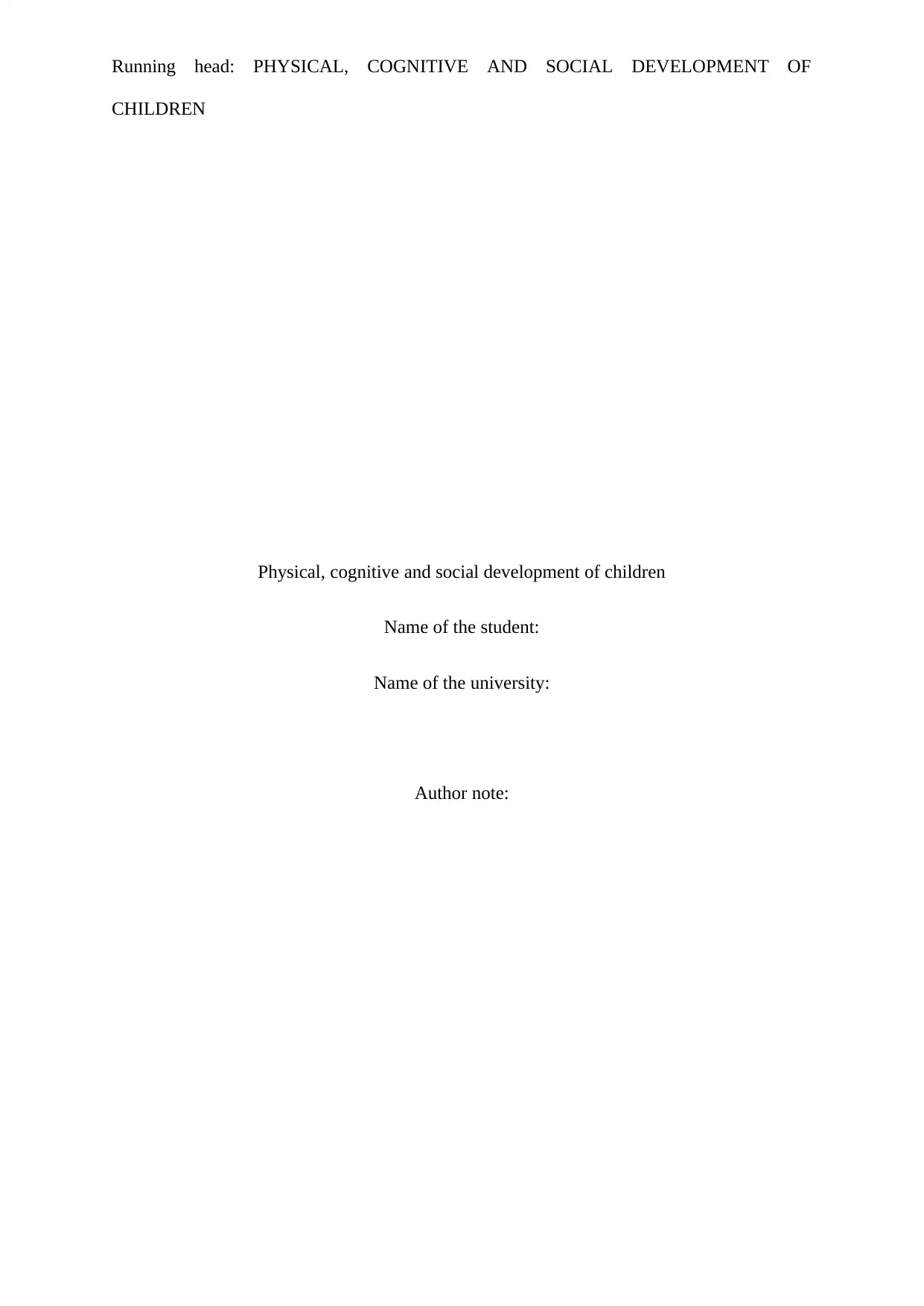
Running head: PHYSICAL, COGNITIVE AND SOCIAL DEVELOPMENT OF
CHILDREN
Physical, cognitive and social development of children
Name of the student:
Name of the university:
Author note:
CHILDREN
Physical, cognitive and social development of children
Name of the student:
Name of the university:
Author note:
Paraphrase This Document
Need a fresh take? Get an instant paraphrase of this document with our AI Paraphraser
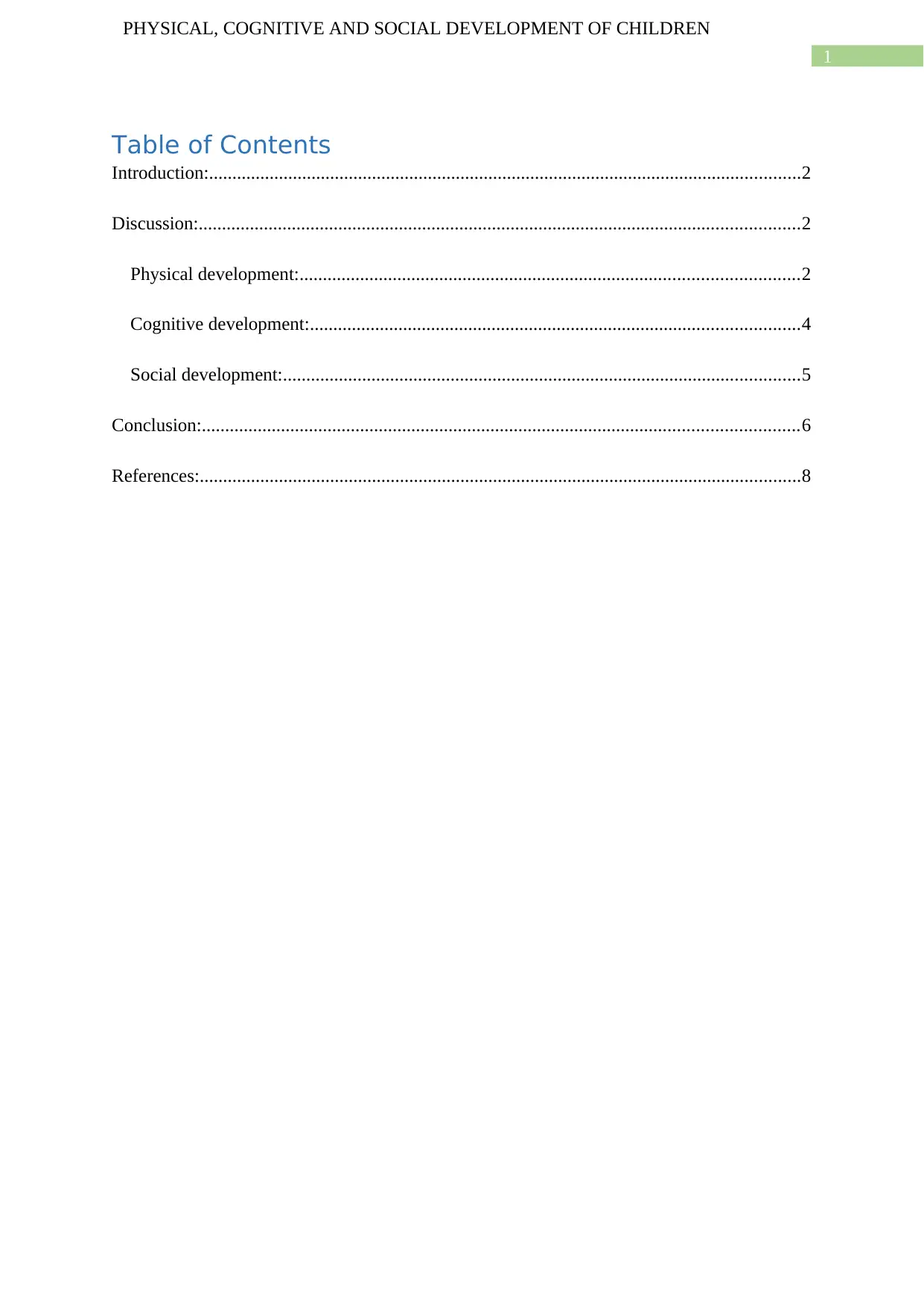
1
PHYSICAL, COGNITIVE AND SOCIAL DEVELOPMENT OF CHILDREN
Table of Contents
Introduction:...............................................................................................................................2
Discussion:.................................................................................................................................2
Physical development:...........................................................................................................2
Cognitive development:.........................................................................................................4
Social development:...............................................................................................................5
Conclusion:................................................................................................................................6
References:.................................................................................................................................8
PHYSICAL, COGNITIVE AND SOCIAL DEVELOPMENT OF CHILDREN
Table of Contents
Introduction:...............................................................................................................................2
Discussion:.................................................................................................................................2
Physical development:...........................................................................................................2
Cognitive development:.........................................................................................................4
Social development:...............................................................................................................5
Conclusion:................................................................................................................................6
References:.................................................................................................................................8
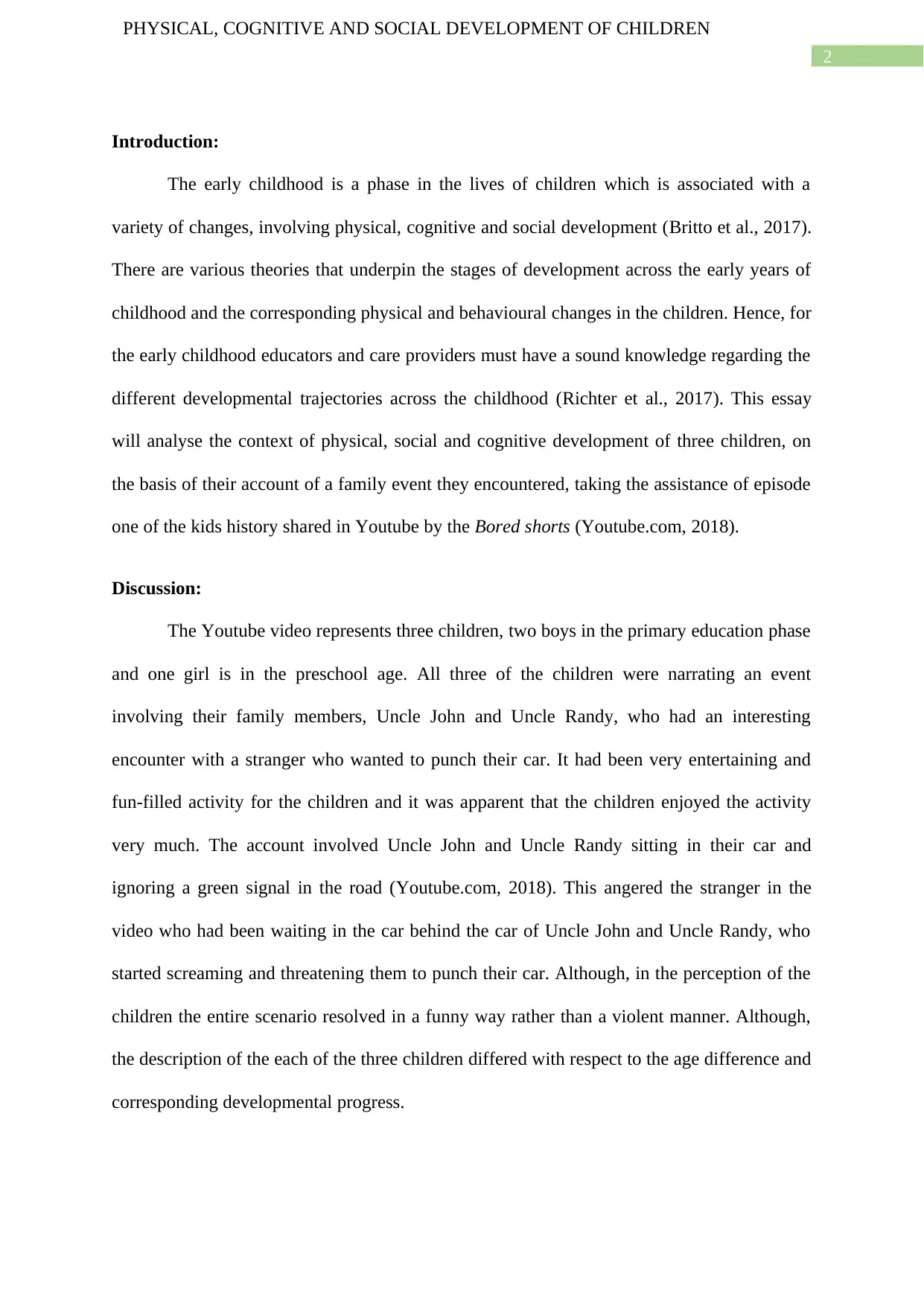
2
PHYSICAL, COGNITIVE AND SOCIAL DEVELOPMENT OF CHILDREN
Introduction:
The early childhood is a phase in the lives of children which is associated with a
variety of changes, involving physical, cognitive and social development (Britto et al., 2017).
There are various theories that underpin the stages of development across the early years of
childhood and the corresponding physical and behavioural changes in the children. Hence, for
the early childhood educators and care providers must have a sound knowledge regarding the
different developmental trajectories across the childhood (Richter et al., 2017). This essay
will analyse the context of physical, social and cognitive development of three children, on
the basis of their account of a family event they encountered, taking the assistance of episode
one of the kids history shared in Youtube by the Bored shorts (Youtube.com, 2018).
Discussion:
The Youtube video represents three children, two boys in the primary education phase
and one girl is in the preschool age. All three of the children were narrating an event
involving their family members, Uncle John and Uncle Randy, who had an interesting
encounter with a stranger who wanted to punch their car. It had been very entertaining and
fun-filled activity for the children and it was apparent that the children enjoyed the activity
very much. The account involved Uncle John and Uncle Randy sitting in their car and
ignoring a green signal in the road (Youtube.com, 2018). This angered the stranger in the
video who had been waiting in the car behind the car of Uncle John and Uncle Randy, who
started screaming and threatening them to punch their car. Although, in the perception of the
children the entire scenario resolved in a funny way rather than a violent manner. Although,
the description of the each of the three children differed with respect to the age difference and
corresponding developmental progress.
PHYSICAL, COGNITIVE AND SOCIAL DEVELOPMENT OF CHILDREN
Introduction:
The early childhood is a phase in the lives of children which is associated with a
variety of changes, involving physical, cognitive and social development (Britto et al., 2017).
There are various theories that underpin the stages of development across the early years of
childhood and the corresponding physical and behavioural changes in the children. Hence, for
the early childhood educators and care providers must have a sound knowledge regarding the
different developmental trajectories across the childhood (Richter et al., 2017). This essay
will analyse the context of physical, social and cognitive development of three children, on
the basis of their account of a family event they encountered, taking the assistance of episode
one of the kids history shared in Youtube by the Bored shorts (Youtube.com, 2018).
Discussion:
The Youtube video represents three children, two boys in the primary education phase
and one girl is in the preschool age. All three of the children were narrating an event
involving their family members, Uncle John and Uncle Randy, who had an interesting
encounter with a stranger who wanted to punch their car. It had been very entertaining and
fun-filled activity for the children and it was apparent that the children enjoyed the activity
very much. The account involved Uncle John and Uncle Randy sitting in their car and
ignoring a green signal in the road (Youtube.com, 2018). This angered the stranger in the
video who had been waiting in the car behind the car of Uncle John and Uncle Randy, who
started screaming and threatening them to punch their car. Although, in the perception of the
children the entire scenario resolved in a funny way rather than a violent manner. Although,
the description of the each of the three children differed with respect to the age difference and
corresponding developmental progress.
⊘ This is a preview!⊘
Do you want full access?
Subscribe today to unlock all pages.

Trusted by 1+ million students worldwide
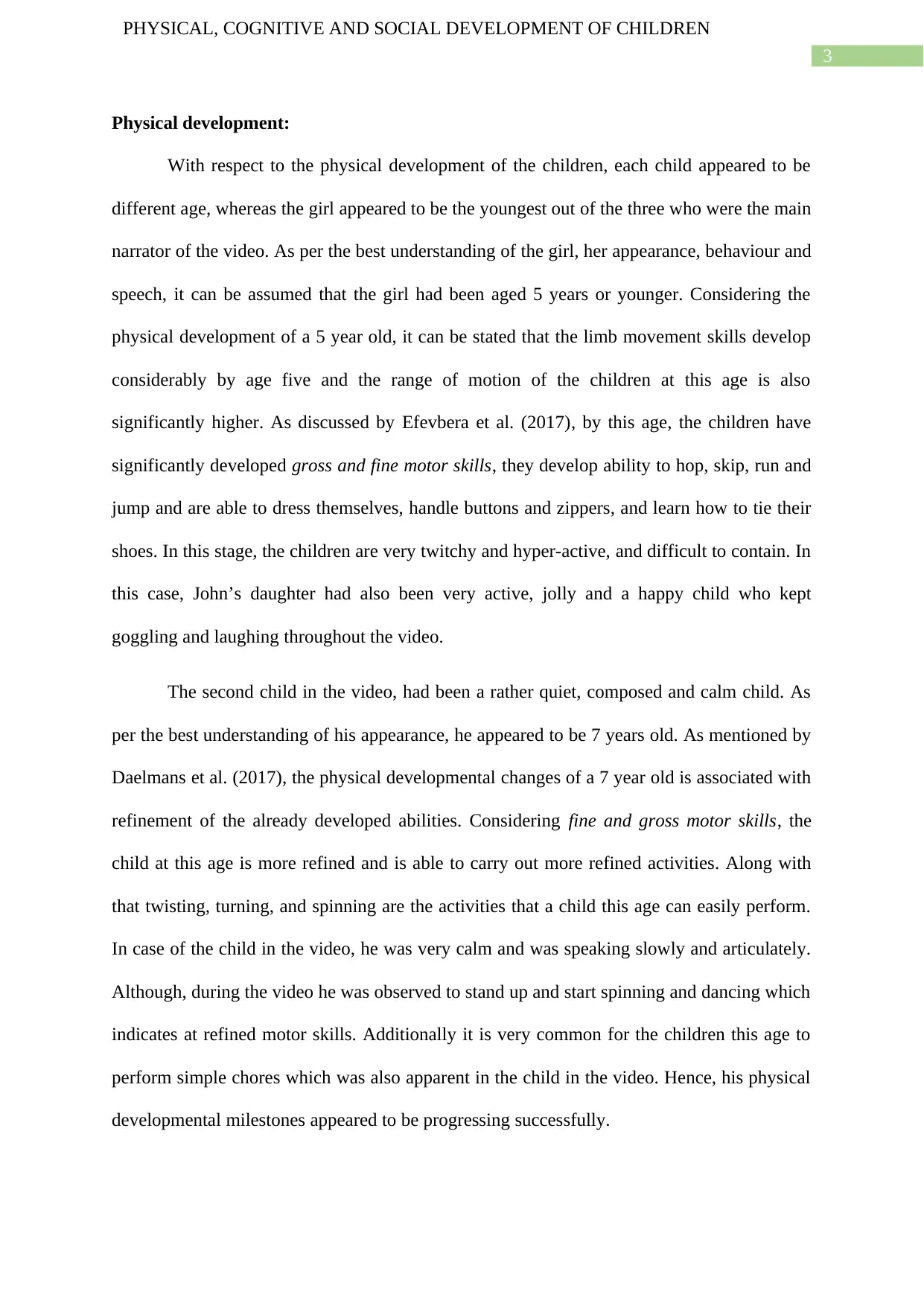
3
PHYSICAL, COGNITIVE AND SOCIAL DEVELOPMENT OF CHILDREN
Physical development:
With respect to the physical development of the children, each child appeared to be
different age, whereas the girl appeared to be the youngest out of the three who were the main
narrator of the video. As per the best understanding of the girl, her appearance, behaviour and
speech, it can be assumed that the girl had been aged 5 years or younger. Considering the
physical development of a 5 year old, it can be stated that the limb movement skills develop
considerably by age five and the range of motion of the children at this age is also
significantly higher. As discussed by Efevbera et al. (2017), by this age, the children have
significantly developed gross and fine motor skills, they develop ability to hop, skip, run and
jump and are able to dress themselves, handle buttons and zippers, and learn how to tie their
shoes. In this stage, the children are very twitchy and hyper-active, and difficult to contain. In
this case, John’s daughter had also been very active, jolly and a happy child who kept
goggling and laughing throughout the video.
The second child in the video, had been a rather quiet, composed and calm child. As
per the best understanding of his appearance, he appeared to be 7 years old. As mentioned by
Daelmans et al. (2017), the physical developmental changes of a 7 year old is associated with
refinement of the already developed abilities. Considering fine and gross motor skills, the
child at this age is more refined and is able to carry out more refined activities. Along with
that twisting, turning, and spinning are the activities that a child this age can easily perform.
In case of the child in the video, he was very calm and was speaking slowly and articulately.
Although, during the video he was observed to stand up and start spinning and dancing which
indicates at refined motor skills. Additionally it is very common for the children this age to
perform simple chores which was also apparent in the child in the video. Hence, his physical
developmental milestones appeared to be progressing successfully.
PHYSICAL, COGNITIVE AND SOCIAL DEVELOPMENT OF CHILDREN
Physical development:
With respect to the physical development of the children, each child appeared to be
different age, whereas the girl appeared to be the youngest out of the three who were the main
narrator of the video. As per the best understanding of the girl, her appearance, behaviour and
speech, it can be assumed that the girl had been aged 5 years or younger. Considering the
physical development of a 5 year old, it can be stated that the limb movement skills develop
considerably by age five and the range of motion of the children at this age is also
significantly higher. As discussed by Efevbera et al. (2017), by this age, the children have
significantly developed gross and fine motor skills, they develop ability to hop, skip, run and
jump and are able to dress themselves, handle buttons and zippers, and learn how to tie their
shoes. In this stage, the children are very twitchy and hyper-active, and difficult to contain. In
this case, John’s daughter had also been very active, jolly and a happy child who kept
goggling and laughing throughout the video.
The second child in the video, had been a rather quiet, composed and calm child. As
per the best understanding of his appearance, he appeared to be 7 years old. As mentioned by
Daelmans et al. (2017), the physical developmental changes of a 7 year old is associated with
refinement of the already developed abilities. Considering fine and gross motor skills, the
child at this age is more refined and is able to carry out more refined activities. Along with
that twisting, turning, and spinning are the activities that a child this age can easily perform.
In case of the child in the video, he was very calm and was speaking slowly and articulately.
Although, during the video he was observed to stand up and start spinning and dancing which
indicates at refined motor skills. Additionally it is very common for the children this age to
perform simple chores which was also apparent in the child in the video. Hence, his physical
developmental milestones appeared to be progressing successfully.
Paraphrase This Document
Need a fresh take? Get an instant paraphrase of this document with our AI Paraphraser
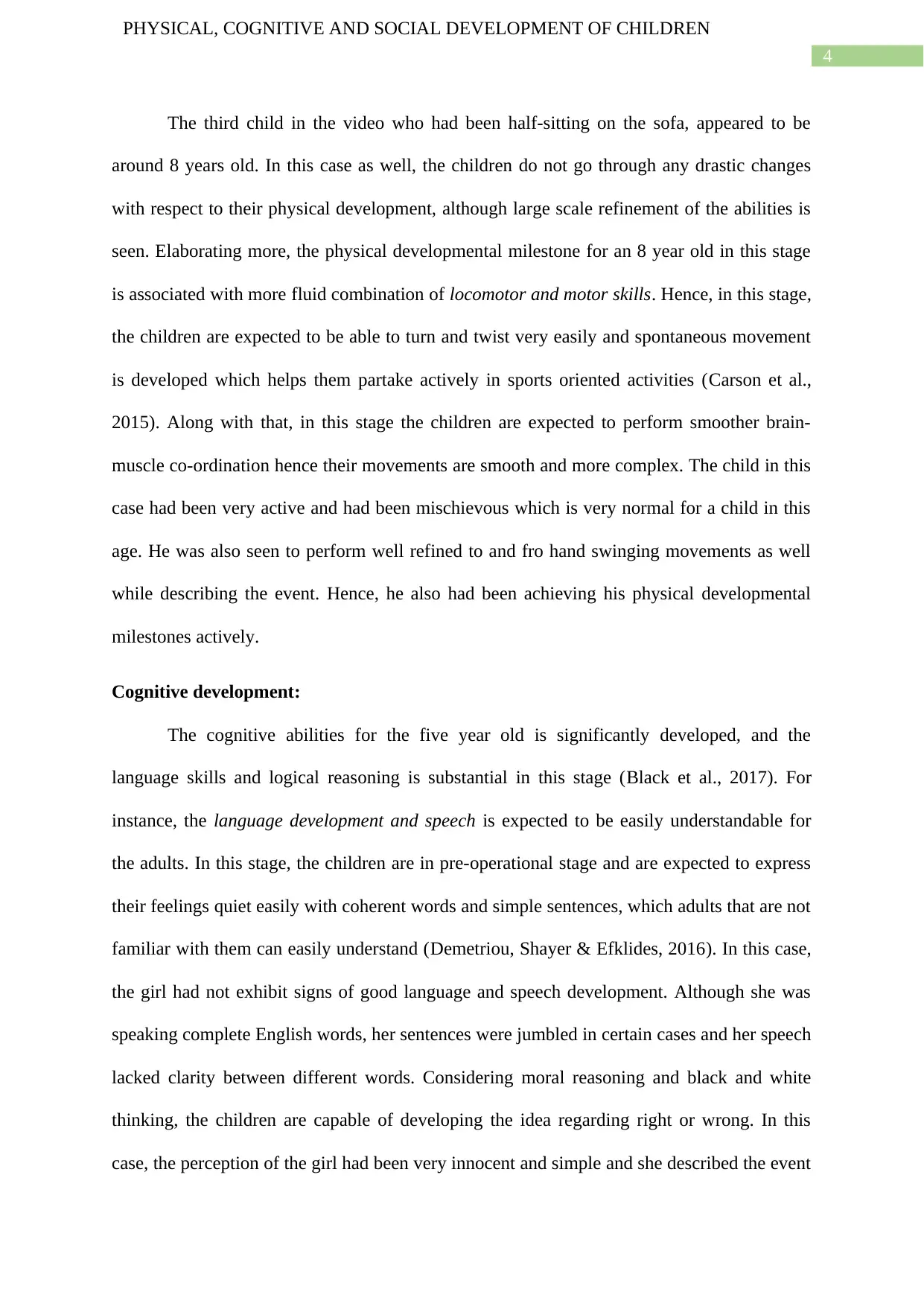
4
PHYSICAL, COGNITIVE AND SOCIAL DEVELOPMENT OF CHILDREN
The third child in the video who had been half-sitting on the sofa, appeared to be
around 8 years old. In this case as well, the children do not go through any drastic changes
with respect to their physical development, although large scale refinement of the abilities is
seen. Elaborating more, the physical developmental milestone for an 8 year old in this stage
is associated with more fluid combination of locomotor and motor skills. Hence, in this stage,
the children are expected to be able to turn and twist very easily and spontaneous movement
is developed which helps them partake actively in sports oriented activities (Carson et al.,
2015). Along with that, in this stage the children are expected to perform smoother brain-
muscle co-ordination hence their movements are smooth and more complex. The child in this
case had been very active and had been mischievous which is very normal for a child in this
age. He was also seen to perform well refined to and fro hand swinging movements as well
while describing the event. Hence, he also had been achieving his physical developmental
milestones actively.
Cognitive development:
The cognitive abilities for the five year old is significantly developed, and the
language skills and logical reasoning is substantial in this stage (Black et al., 2017). For
instance, the language development and speech is expected to be easily understandable for
the adults. In this stage, the children are in pre-operational stage and are expected to express
their feelings quiet easily with coherent words and simple sentences, which adults that are not
familiar with them can easily understand (Demetriou, Shayer & Efklides, 2016). In this case,
the girl had not exhibit signs of good language and speech development. Although she was
speaking complete English words, her sentences were jumbled in certain cases and her speech
lacked clarity between different words. Considering moral reasoning and black and white
thinking, the children are capable of developing the idea regarding right or wrong. In this
case, the perception of the girl had been very innocent and simple and she described the event
PHYSICAL, COGNITIVE AND SOCIAL DEVELOPMENT OF CHILDREN
The third child in the video who had been half-sitting on the sofa, appeared to be
around 8 years old. In this case as well, the children do not go through any drastic changes
with respect to their physical development, although large scale refinement of the abilities is
seen. Elaborating more, the physical developmental milestone for an 8 year old in this stage
is associated with more fluid combination of locomotor and motor skills. Hence, in this stage,
the children are expected to be able to turn and twist very easily and spontaneous movement
is developed which helps them partake actively in sports oriented activities (Carson et al.,
2015). Along with that, in this stage the children are expected to perform smoother brain-
muscle co-ordination hence their movements are smooth and more complex. The child in this
case had been very active and had been mischievous which is very normal for a child in this
age. He was also seen to perform well refined to and fro hand swinging movements as well
while describing the event. Hence, he also had been achieving his physical developmental
milestones actively.
Cognitive development:
The cognitive abilities for the five year old is significantly developed, and the
language skills and logical reasoning is substantial in this stage (Black et al., 2017). For
instance, the language development and speech is expected to be easily understandable for
the adults. In this stage, the children are in pre-operational stage and are expected to express
their feelings quiet easily with coherent words and simple sentences, which adults that are not
familiar with them can easily understand (Demetriou, Shayer & Efklides, 2016). In this case,
the girl had not exhibit signs of good language and speech development. Although she was
speaking complete English words, her sentences were jumbled in certain cases and her speech
lacked clarity between different words. Considering moral reasoning and black and white
thinking, the children are capable of developing the idea regarding right or wrong. In this
case, the perception of the girl had been very innocent and simple and she described the event
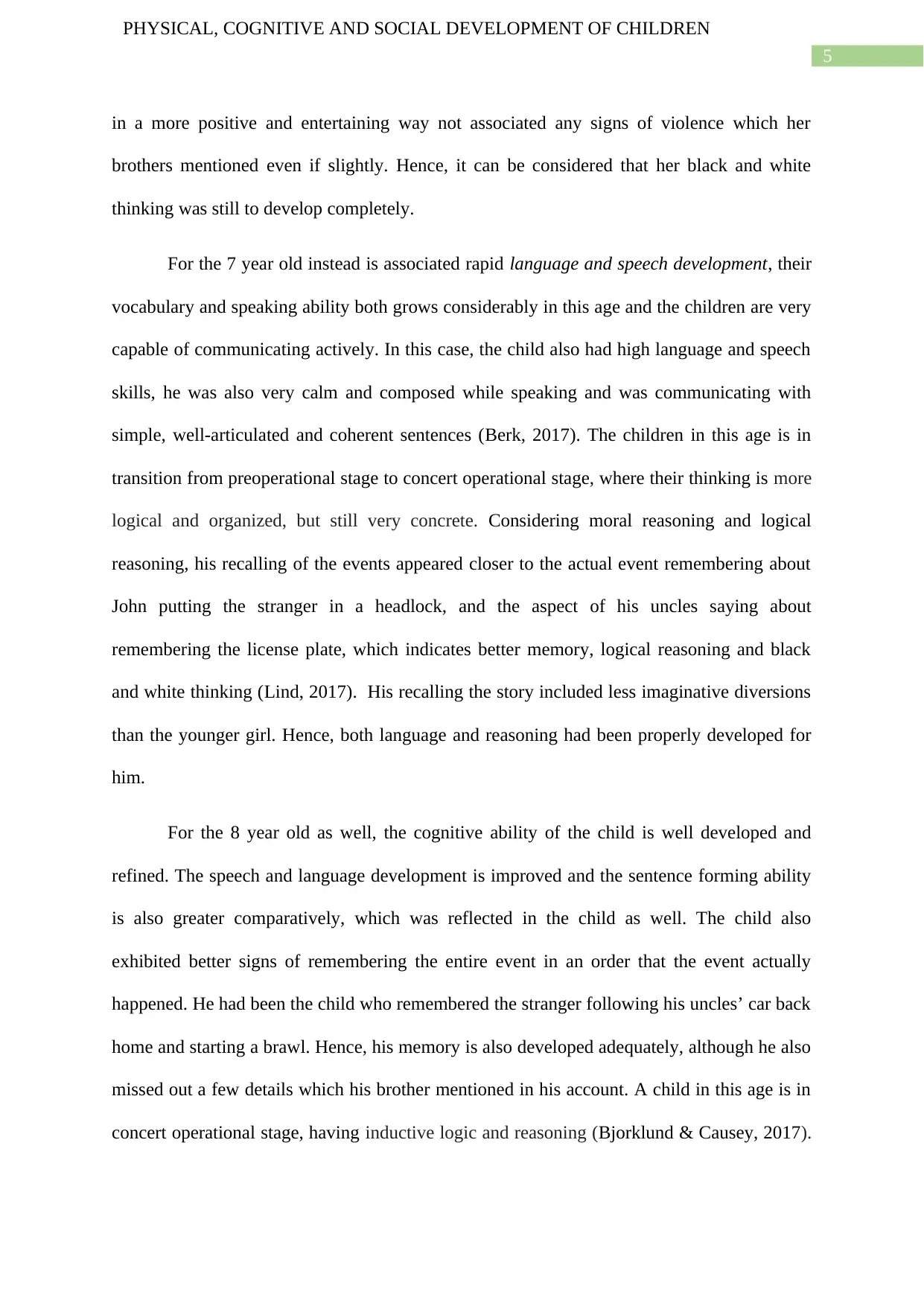
5
PHYSICAL, COGNITIVE AND SOCIAL DEVELOPMENT OF CHILDREN
in a more positive and entertaining way not associated any signs of violence which her
brothers mentioned even if slightly. Hence, it can be considered that her black and white
thinking was still to develop completely.
For the 7 year old instead is associated rapid language and speech development, their
vocabulary and speaking ability both grows considerably in this age and the children are very
capable of communicating actively. In this case, the child also had high language and speech
skills, he was also very calm and composed while speaking and was communicating with
simple, well-articulated and coherent sentences (Berk, 2017). The children in this age is in
transition from preoperational stage to concert operational stage, where their thinking is more
logical and organized, but still very concrete. Considering moral reasoning and logical
reasoning, his recalling of the events appeared closer to the actual event remembering about
John putting the stranger in a headlock, and the aspect of his uncles saying about
remembering the license plate, which indicates better memory, logical reasoning and black
and white thinking (Lind, 2017). His recalling the story included less imaginative diversions
than the younger girl. Hence, both language and reasoning had been properly developed for
him.
For the 8 year old as well, the cognitive ability of the child is well developed and
refined. The speech and language development is improved and the sentence forming ability
is also greater comparatively, which was reflected in the child as well. The child also
exhibited better signs of remembering the entire event in an order that the event actually
happened. He had been the child who remembered the stranger following his uncles’ car back
home and starting a brawl. Hence, his memory is also developed adequately, although he also
missed out a few details which his brother mentioned in his account. A child in this age is in
concert operational stage, having inductive logic and reasoning (Bjorklund & Causey, 2017).
PHYSICAL, COGNITIVE AND SOCIAL DEVELOPMENT OF CHILDREN
in a more positive and entertaining way not associated any signs of violence which her
brothers mentioned even if slightly. Hence, it can be considered that her black and white
thinking was still to develop completely.
For the 7 year old instead is associated rapid language and speech development, their
vocabulary and speaking ability both grows considerably in this age and the children are very
capable of communicating actively. In this case, the child also had high language and speech
skills, he was also very calm and composed while speaking and was communicating with
simple, well-articulated and coherent sentences (Berk, 2017). The children in this age is in
transition from preoperational stage to concert operational stage, where their thinking is more
logical and organized, but still very concrete. Considering moral reasoning and logical
reasoning, his recalling of the events appeared closer to the actual event remembering about
John putting the stranger in a headlock, and the aspect of his uncles saying about
remembering the license plate, which indicates better memory, logical reasoning and black
and white thinking (Lind, 2017). His recalling the story included less imaginative diversions
than the younger girl. Hence, both language and reasoning had been properly developed for
him.
For the 8 year old as well, the cognitive ability of the child is well developed and
refined. The speech and language development is improved and the sentence forming ability
is also greater comparatively, which was reflected in the child as well. The child also
exhibited better signs of remembering the entire event in an order that the event actually
happened. He had been the child who remembered the stranger following his uncles’ car back
home and starting a brawl. Hence, his memory is also developed adequately, although he also
missed out a few details which his brother mentioned in his account. A child in this age is in
concert operational stage, having inductive logic and reasoning (Bjorklund & Causey, 2017).
⊘ This is a preview!⊘
Do you want full access?
Subscribe today to unlock all pages.

Trusted by 1+ million students worldwide
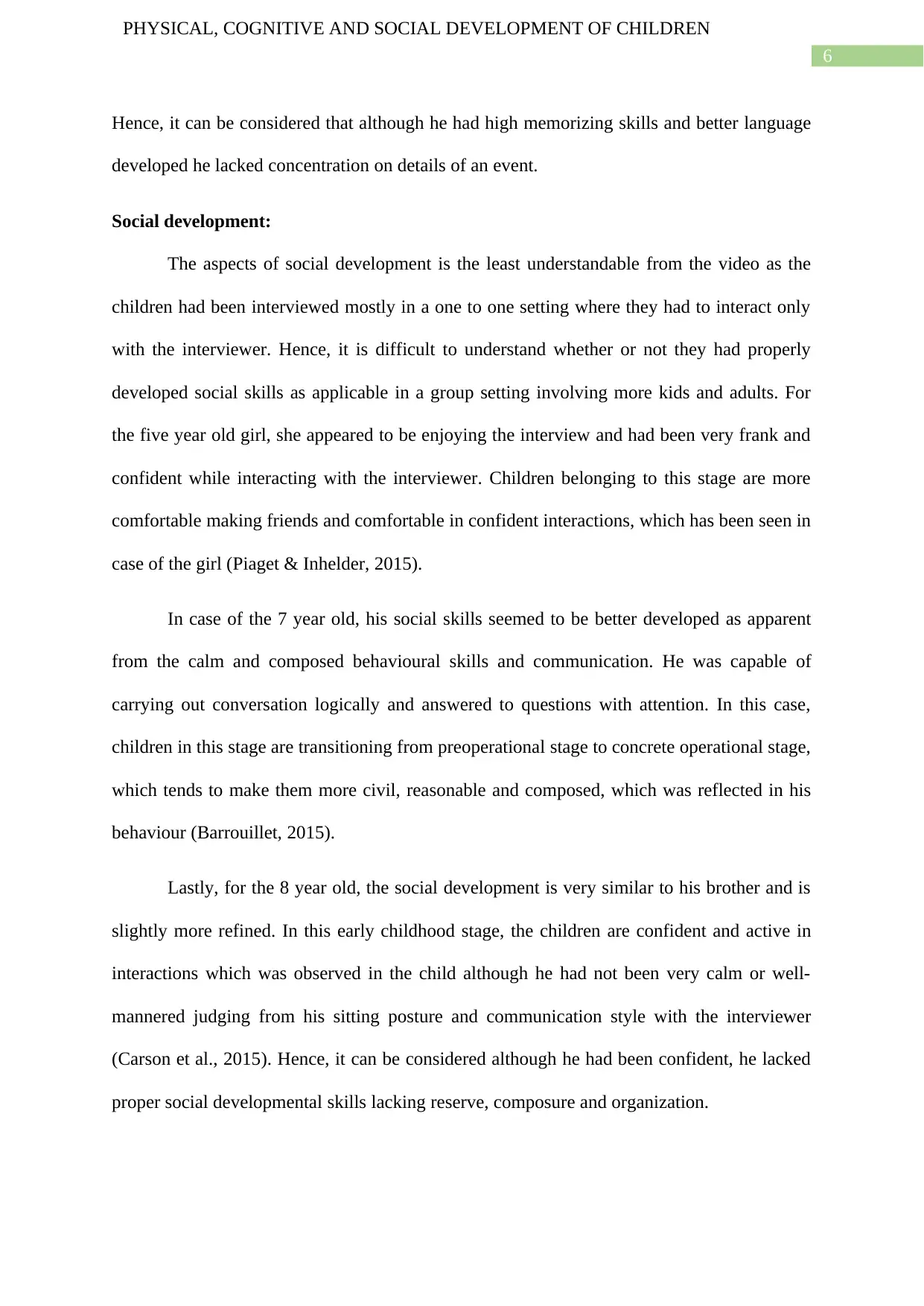
6
PHYSICAL, COGNITIVE AND SOCIAL DEVELOPMENT OF CHILDREN
Hence, it can be considered that although he had high memorizing skills and better language
developed he lacked concentration on details of an event.
Social development:
The aspects of social development is the least understandable from the video as the
children had been interviewed mostly in a one to one setting where they had to interact only
with the interviewer. Hence, it is difficult to understand whether or not they had properly
developed social skills as applicable in a group setting involving more kids and adults. For
the five year old girl, she appeared to be enjoying the interview and had been very frank and
confident while interacting with the interviewer. Children belonging to this stage are more
comfortable making friends and comfortable in confident interactions, which has been seen in
case of the girl (Piaget & Inhelder, 2015).
In case of the 7 year old, his social skills seemed to be better developed as apparent
from the calm and composed behavioural skills and communication. He was capable of
carrying out conversation logically and answered to questions with attention. In this case,
children in this stage are transitioning from preoperational stage to concrete operational stage,
which tends to make them more civil, reasonable and composed, which was reflected in his
behaviour (Barrouillet, 2015).
Lastly, for the 8 year old, the social development is very similar to his brother and is
slightly more refined. In this early childhood stage, the children are confident and active in
interactions which was observed in the child although he had not been very calm or well-
mannered judging from his sitting posture and communication style with the interviewer
(Carson et al., 2015). Hence, it can be considered although he had been confident, he lacked
proper social developmental skills lacking reserve, composure and organization.
PHYSICAL, COGNITIVE AND SOCIAL DEVELOPMENT OF CHILDREN
Hence, it can be considered that although he had high memorizing skills and better language
developed he lacked concentration on details of an event.
Social development:
The aspects of social development is the least understandable from the video as the
children had been interviewed mostly in a one to one setting where they had to interact only
with the interviewer. Hence, it is difficult to understand whether or not they had properly
developed social skills as applicable in a group setting involving more kids and adults. For
the five year old girl, she appeared to be enjoying the interview and had been very frank and
confident while interacting with the interviewer. Children belonging to this stage are more
comfortable making friends and comfortable in confident interactions, which has been seen in
case of the girl (Piaget & Inhelder, 2015).
In case of the 7 year old, his social skills seemed to be better developed as apparent
from the calm and composed behavioural skills and communication. He was capable of
carrying out conversation logically and answered to questions with attention. In this case,
children in this stage are transitioning from preoperational stage to concrete operational stage,
which tends to make them more civil, reasonable and composed, which was reflected in his
behaviour (Barrouillet, 2015).
Lastly, for the 8 year old, the social development is very similar to his brother and is
slightly more refined. In this early childhood stage, the children are confident and active in
interactions which was observed in the child although he had not been very calm or well-
mannered judging from his sitting posture and communication style with the interviewer
(Carson et al., 2015). Hence, it can be considered although he had been confident, he lacked
proper social developmental skills lacking reserve, composure and organization.
Paraphrase This Document
Need a fresh take? Get an instant paraphrase of this document with our AI Paraphraser
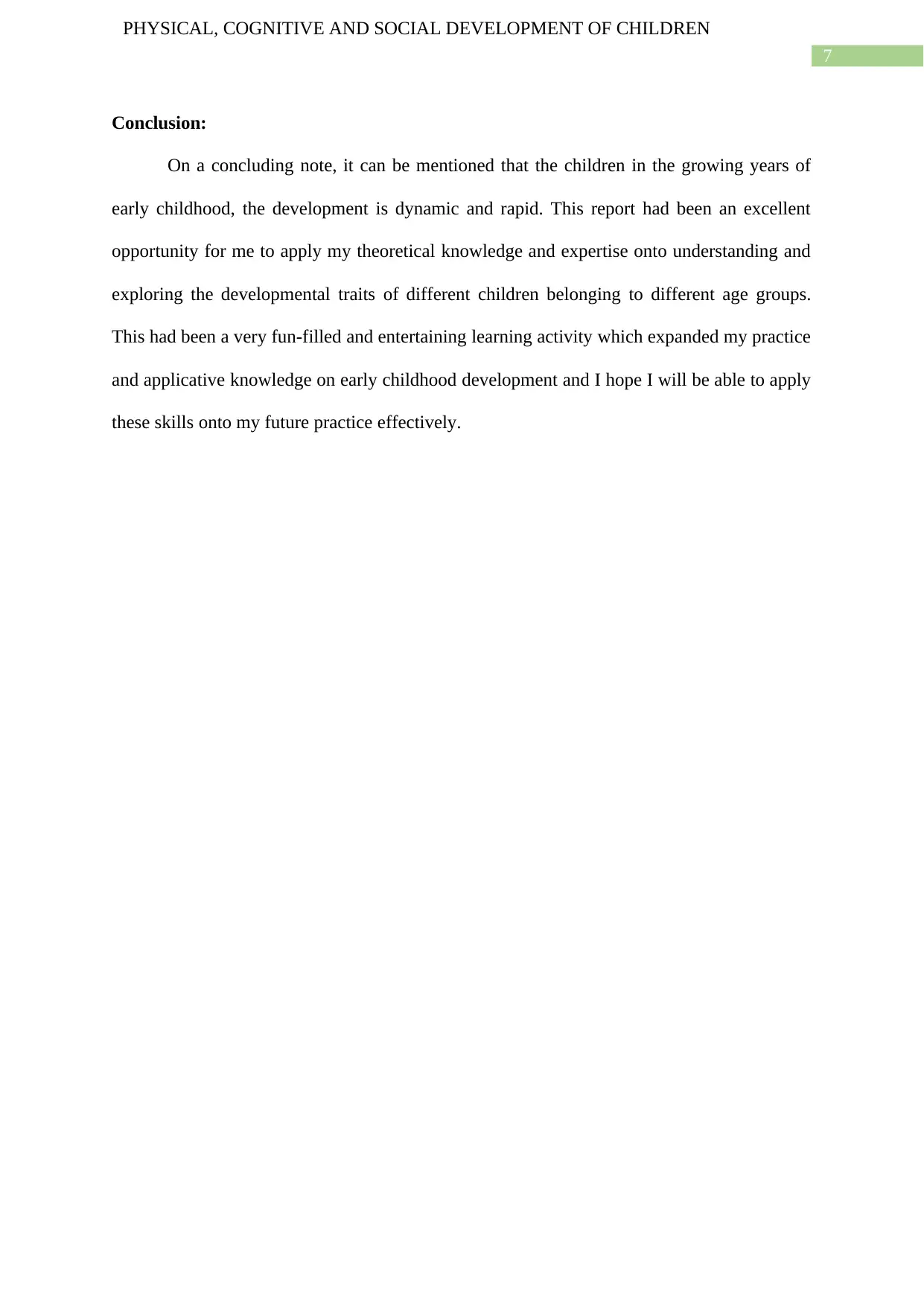
7
PHYSICAL, COGNITIVE AND SOCIAL DEVELOPMENT OF CHILDREN
Conclusion:
On a concluding note, it can be mentioned that the children in the growing years of
early childhood, the development is dynamic and rapid. This report had been an excellent
opportunity for me to apply my theoretical knowledge and expertise onto understanding and
exploring the developmental traits of different children belonging to different age groups.
This had been a very fun-filled and entertaining learning activity which expanded my practice
and applicative knowledge on early childhood development and I hope I will be able to apply
these skills onto my future practice effectively.
PHYSICAL, COGNITIVE AND SOCIAL DEVELOPMENT OF CHILDREN
Conclusion:
On a concluding note, it can be mentioned that the children in the growing years of
early childhood, the development is dynamic and rapid. This report had been an excellent
opportunity for me to apply my theoretical knowledge and expertise onto understanding and
exploring the developmental traits of different children belonging to different age groups.
This had been a very fun-filled and entertaining learning activity which expanded my practice
and applicative knowledge on early childhood development and I hope I will be able to apply
these skills onto my future practice effectively.
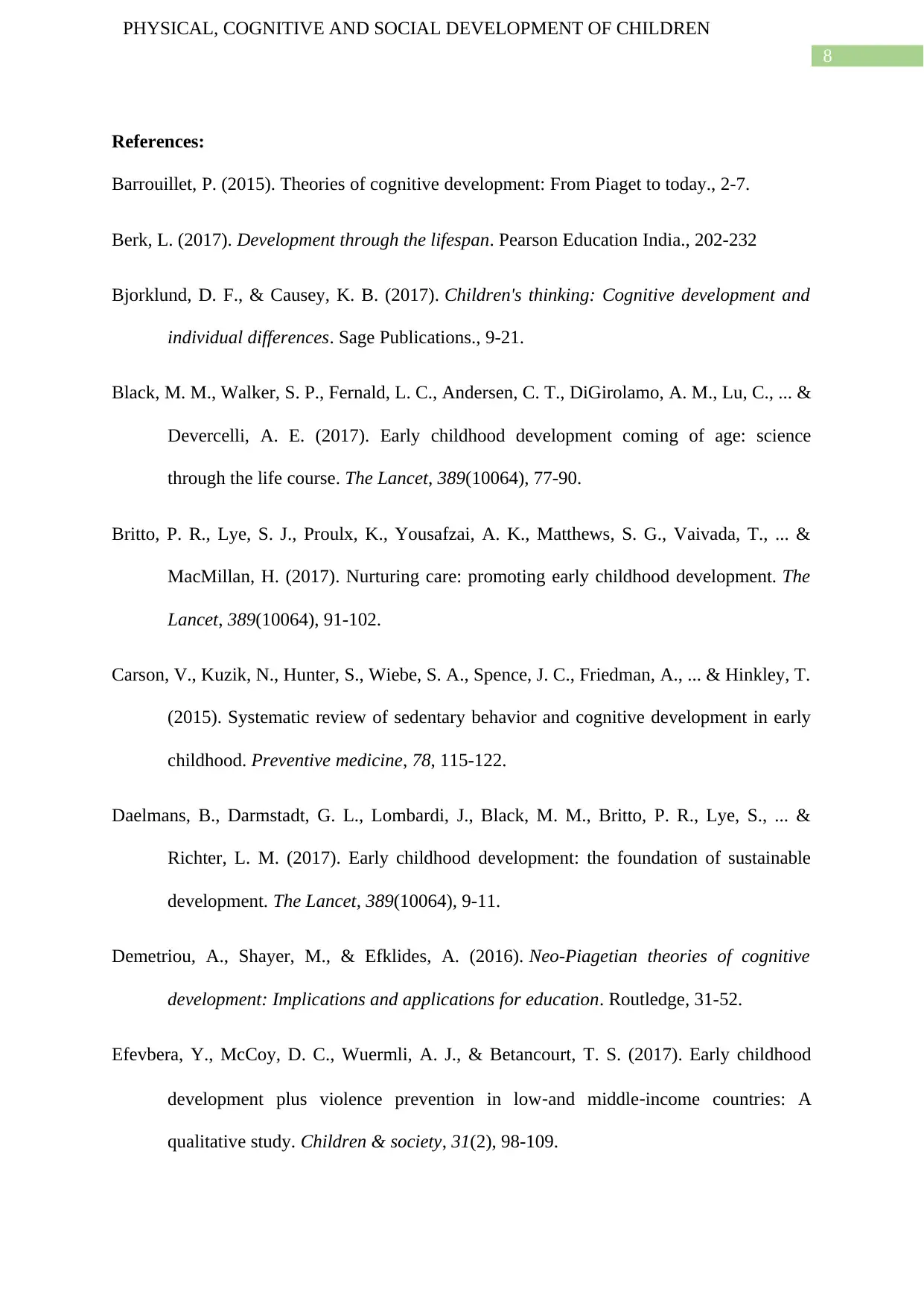
8
PHYSICAL, COGNITIVE AND SOCIAL DEVELOPMENT OF CHILDREN
References:
Barrouillet, P. (2015). Theories of cognitive development: From Piaget to today., 2-7.
Berk, L. (2017). Development through the lifespan. Pearson Education India., 202-232
Bjorklund, D. F., & Causey, K. B. (2017). Children's thinking: Cognitive development and
individual differences. Sage Publications., 9-21.
Black, M. M., Walker, S. P., Fernald, L. C., Andersen, C. T., DiGirolamo, A. M., Lu, C., ... &
Devercelli, A. E. (2017). Early childhood development coming of age: science
through the life course. The Lancet, 389(10064), 77-90.
Britto, P. R., Lye, S. J., Proulx, K., Yousafzai, A. K., Matthews, S. G., Vaivada, T., ... &
MacMillan, H. (2017). Nurturing care: promoting early childhood development. The
Lancet, 389(10064), 91-102.
Carson, V., Kuzik, N., Hunter, S., Wiebe, S. A., Spence, J. C., Friedman, A., ... & Hinkley, T.
(2015). Systematic review of sedentary behavior and cognitive development in early
childhood. Preventive medicine, 78, 115-122.
Daelmans, B., Darmstadt, G. L., Lombardi, J., Black, M. M., Britto, P. R., Lye, S., ... &
Richter, L. M. (2017). Early childhood development: the foundation of sustainable
development. The Lancet, 389(10064), 9-11.
Demetriou, A., Shayer, M., & Efklides, A. (2016). Neo-Piagetian theories of cognitive
development: Implications and applications for education. Routledge, 31-52.
Efevbera, Y., McCoy, D. C., Wuermli, A. J., & Betancourt, T. S. (2017). Early childhood
development plus violence prevention in low‐and middle‐income countries: A
qualitative study. Children & society, 31(2), 98-109.
PHYSICAL, COGNITIVE AND SOCIAL DEVELOPMENT OF CHILDREN
References:
Barrouillet, P. (2015). Theories of cognitive development: From Piaget to today., 2-7.
Berk, L. (2017). Development through the lifespan. Pearson Education India., 202-232
Bjorklund, D. F., & Causey, K. B. (2017). Children's thinking: Cognitive development and
individual differences. Sage Publications., 9-21.
Black, M. M., Walker, S. P., Fernald, L. C., Andersen, C. T., DiGirolamo, A. M., Lu, C., ... &
Devercelli, A. E. (2017). Early childhood development coming of age: science
through the life course. The Lancet, 389(10064), 77-90.
Britto, P. R., Lye, S. J., Proulx, K., Yousafzai, A. K., Matthews, S. G., Vaivada, T., ... &
MacMillan, H. (2017). Nurturing care: promoting early childhood development. The
Lancet, 389(10064), 91-102.
Carson, V., Kuzik, N., Hunter, S., Wiebe, S. A., Spence, J. C., Friedman, A., ... & Hinkley, T.
(2015). Systematic review of sedentary behavior and cognitive development in early
childhood. Preventive medicine, 78, 115-122.
Daelmans, B., Darmstadt, G. L., Lombardi, J., Black, M. M., Britto, P. R., Lye, S., ... &
Richter, L. M. (2017). Early childhood development: the foundation of sustainable
development. The Lancet, 389(10064), 9-11.
Demetriou, A., Shayer, M., & Efklides, A. (2016). Neo-Piagetian theories of cognitive
development: Implications and applications for education. Routledge, 31-52.
Efevbera, Y., McCoy, D. C., Wuermli, A. J., & Betancourt, T. S. (2017). Early childhood
development plus violence prevention in low‐and middle‐income countries: A
qualitative study. Children & society, 31(2), 98-109.
⊘ This is a preview!⊘
Do you want full access?
Subscribe today to unlock all pages.

Trusted by 1+ million students worldwide
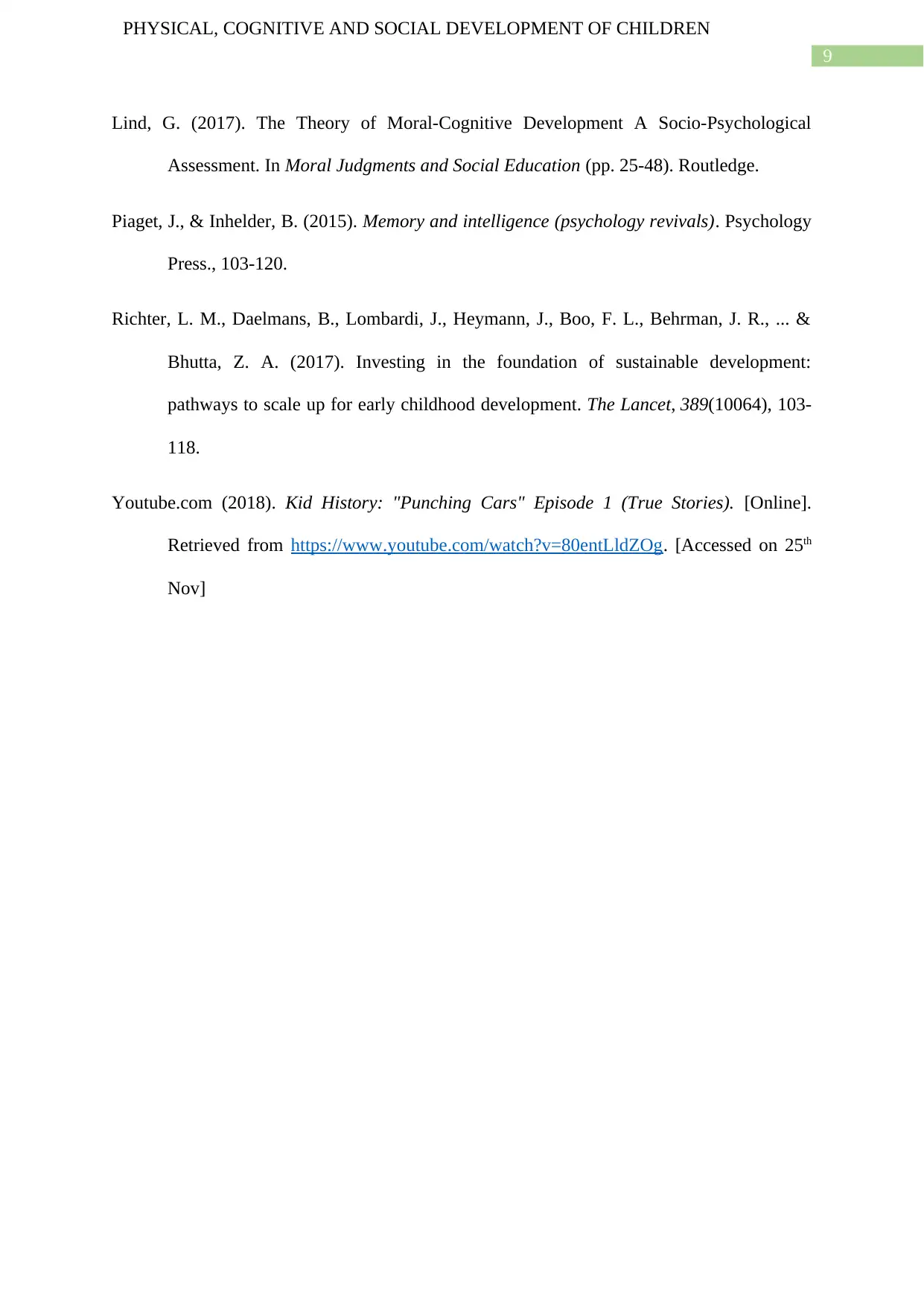
9
PHYSICAL, COGNITIVE AND SOCIAL DEVELOPMENT OF CHILDREN
Lind, G. (2017). The Theory of Moral-Cognitive Development A Socio-Psychological
Assessment. In Moral Judgments and Social Education (pp. 25-48). Routledge.
Piaget, J., & Inhelder, B. (2015). Memory and intelligence (psychology revivals). Psychology
Press., 103-120.
Richter, L. M., Daelmans, B., Lombardi, J., Heymann, J., Boo, F. L., Behrman, J. R., ... &
Bhutta, Z. A. (2017). Investing in the foundation of sustainable development:
pathways to scale up for early childhood development. The Lancet, 389(10064), 103-
118.
Youtube.com (2018). Kid History: "Punching Cars" Episode 1 (True Stories). [Online].
Retrieved from https://www.youtube.com/watch?v=80entLldZOg. [Accessed on 25th
Nov]
PHYSICAL, COGNITIVE AND SOCIAL DEVELOPMENT OF CHILDREN
Lind, G. (2017). The Theory of Moral-Cognitive Development A Socio-Psychological
Assessment. In Moral Judgments and Social Education (pp. 25-48). Routledge.
Piaget, J., & Inhelder, B. (2015). Memory and intelligence (psychology revivals). Psychology
Press., 103-120.
Richter, L. M., Daelmans, B., Lombardi, J., Heymann, J., Boo, F. L., Behrman, J. R., ... &
Bhutta, Z. A. (2017). Investing in the foundation of sustainable development:
pathways to scale up for early childhood development. The Lancet, 389(10064), 103-
118.
Youtube.com (2018). Kid History: "Punching Cars" Episode 1 (True Stories). [Online].
Retrieved from https://www.youtube.com/watch?v=80entLldZOg. [Accessed on 25th
Nov]
1 out of 10
Related Documents
Your All-in-One AI-Powered Toolkit for Academic Success.
+13062052269
info@desklib.com
Available 24*7 on WhatsApp / Email
![[object Object]](/_next/static/media/star-bottom.7253800d.svg)
Unlock your academic potential
Copyright © 2020–2025 A2Z Services. All Rights Reserved. Developed and managed by ZUCOL.




